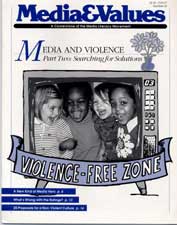20 Ways to Create a Caring Culture - Part I
|
This article originally appeared in Issue# 63
|
Stories of violence are familiar to anyone with a television in America today. Whether flashed on the nightly news, dramatized in a sensational movie of the week or packed into "action" blockbuster films (a guy, a gun and an attitude!), not a day goes by that we don't get a dose of aggression from the media. And it's getting worse.
Recent cover articles in Time and Newsweek have detailed the rising wave of violence holding society hostage in a culture of conflict and fear. Especially alarming is the news of the increase in crime committed by children -- often with guns. Watching these seemingly endless reports of real-life brutality in tandem with the barrage of fictional violence euphemised as "action" in films and on television, we have to ask: why in the world are we killing each other?
Indeed, this is a crossroad in our cultural and social history. Do we remain victimized by a violent media culture, or do we work to create a peaceful society where we feel safe in our homes, on our streets and in our communities?
What kind of culture do we want our children to grow up in?
It's Up to Us
Without a doubt, decades of media violence have made art of deadly aggression and helped erode our sense of peace and security. But it no longer has to be that way. Most of us prefer a "people safe" world -- a society that nurtures individual growth, fosters healthy relationships and respects the diversity of cultures worldwide. It's what we're constantly striving for. We're continually pursuing solutions to difficult problems that will improve our quality of life. Take, for instance, the environmental movement.
Reports of a depleting ozone layer, diminishing rain forest, devastating oil spills and other environmental disasters set off an alarm: We are destroying our planet. Faced with a future of living in a toxic world, we realized we had to save the earth to save ourselves.
Today, we recycle our cans, bottles and newspapers. We conserve water. Chlorofluorocarbons are banned. Industries must adhere to strict pollution controls. We celebrate an annual "Earth Day" to re-affirm our global commitment to preserving our planet's natural resources.
This same vision and energy is needed to transform our culture of violence into a culture of caring. We must make the commitment to ourselves and to our children to make our world less violent than the day before. We have to. For, like our still-endangered blue planet, no less than the future of our children is at stake.
A Positive Approach
On July 15, 1993 the Center for Media and Values [now Center for Media Literacy], with funding and participation from Mediascope, a Los Angeles-based non-profit advocacy organization working to improve the depiction of health and social issues in entertainment, held a small, informal consultation on Challenging our Culture of Violence. The idea of the consultation was to brainstorm new directions for framing solutions to the media violence crisis.
In addition to CMV and Mediascope staff, a number of local Los Angeles educators and community leaders were invited to share their expertise. Participants included Ann Desmond, vice president for communications of the California PTA; Keiko Hentell, principal of Burbank High School; Rev. Alvin Hawkins, board chair, United Methodist Jr. Basketball League & Youth Development Project; Casandra Hawkings, Teacher Training Magnet, Los Angeles Unified School District and "Teacher of the Year;" Frederica Burrows, retired elementary educator, Glendale public schools; Barbara Wilson, associate professor of communications at the University of California/Santa Barbara; and Phyllis Steinberg, School Mediation Services, Los Angeles County Bar Association. The event was facilitated by Professor Ian Mitroff, director of the Center for Crisis Management at the University of Southern California .
The participants concentrated on generating ideas and tried to avoid being discouraged by the complexity of the issue. The result of the open forum was an impressive list of media-based proposals for reducing media violence.
Granted, some of these are broad-stroke solutions to a problem that has far-reaching causes and effects. But that's the point. Collectively, they symbolize a movement toward nonviolence. A step in a positive and healthy direction. A profound commitment toward creating a "people safe" world.
More importantly, many of the group's proposals are family-oriented and community-based. Too often, finding solutions to media violence is dumped on members of Congress, network TV executives or engineers working on V-Chips and lock boxes. But we all must share in this national task.
Consultation participants discovered that there's a lot each of us can do right now to lessen the impact of media violence in our personal and family lives. It's far easier to work with your local television station and newspaper, for example, than a national network or publication. Local efforts avoid debilitating bureauracracy and encourage immediate action where it's needed most: in our homes and our neighborhoods. And eventually, those small actions add up to influence national policies and change national priorities.
The following 20 proposals expanded from the best of the consultation's list of ideas represent an unrestricted, solution-minded, community-based approach to the problem of media violence. At their core is the quest for a non-violent society. They're also an invitation to you to join communities everywhere in transforming our culture of violence into a culture of caring.
Finding a solution to the violence epidemic will take time and effort. However, doing nothing will guarantee the status quo of mayhem on the street and on the screen. With so much at stake, we can no longer afford to sit in our LazyBoys and watch a murderous world go by.



